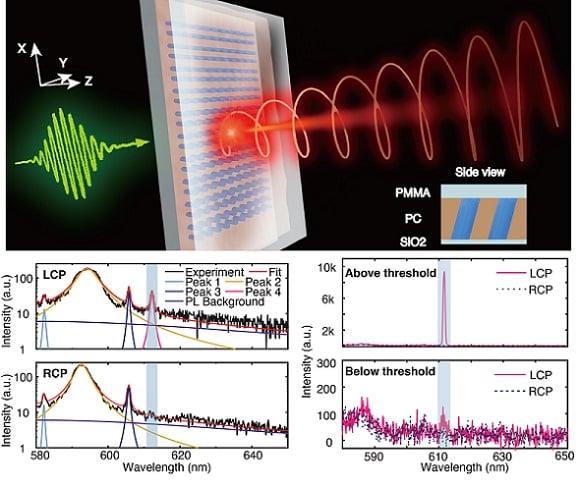
Light Source Gives Quantum Info Processing a Sense of Direction
HARBIN, China, Sept. 21, 2022 — Researchers from Harbin Institute of Technology and Australian National University used bulk states in the continuum (BICs) to develop metasurfaces — doped with light-emitting molecules — that operate as compact sources of chiral light. The researchers’ efficient, controllable emission mechanism for circularly polarized light also yielded chiral lasing.
According to the researchers, the method will be useful for the development of integrated optical devices. Up to now, they said, a strategy for simultaneous control of chiral spontaneous emission and chiral lasing remains undeveloped.

High-purity circularly polarized spontaneous emission and lasing from the resonant metasurface with near-unity intrinsic chirality. Courtesy of Xudong Zhang.
An ultracompact, circularly polarized light source is a crucial component for classical and quantum optics information processing — though conventional approaches for circularly polarized photoluminescence suffer from multiple drawbacks. These include incoherent broadband emission, limited degree(s) of polarization (DOP), and large radiating angles. In addition, according to the researchers, practical applications for these light sources are constrained by low efficiency and energy waste to undesired handedness and emission directions. Chiral microlasers can have large DOPs and directional output, but only in specific power ranges. Further, their subthreshold performances plummet significantly.
To create resonant metasurfaces for chiral emission, the researchers formed quasi-BICs by introducing in-plane asymmetry into BICs. According to the researchers, BICs with integer topological charge in momentum space and a theoretically infinite quality (Q) factor have been explored for many applications. The Q factor in quasi-BICS is high, but finite.
The integer topological charge of BIC mode splits into two half-integer charges, which correspond to left- and right-handed circular polarization states, known as C-points. At the C-points, incident light with one circular polarization state can be coupled into nanostructures to produce local electromagnetic fields. The other polarization state is decoupled and transmitted almost perfectly.
The characteristics of light at C-points are rarely applied to light emissions. According to professor Xudong Zhang, this is mainly because the C-points usually deviate from the bottom of band. The C-points have a relatively low Q factor and cannot be excited for lasing actions, Zhang said.
The researchers combined the local density of states with the intrinsic chirality at the C-points. If one C-point is shifted to the bottom of the band, the Q factor of the corresponding chiral quasi-BIC can be maximal. As the radiation rate of one circularly polarized spontaneous emission is enhanced, the other polarization is inhibited. Both the Q factor and the radiation rate are reduced with the emission angle. As a result, high-purity, directional light emission can be expected near the Γ point.
“The other C-point can support similar high chirality with opposite handedness,” Zhang said. “However, that point also deviates from the maximal Q factor. Therefore, our metasurface only produces one near-unity circular polarization with high directionality around the normal direction.”
The control of C-points in momentum space is closely related to the maximization of chirality in the normal direction. In principle, the realization of chirality relates to the simultaneous breaking of in-plane and out-of-plane mirror reflection symmetries.
The researchers used an out-of-plane asymmetry — the tilt of nanostructures — in their work. “We find two types of asymmetries are linearly dependent on one another,” Zhang said. “This makes the optimization of chirality in [a] normal direction very easy.”
In experiments, the researchers fabricated the metasurfaces using a one-step, slanted, reactive ion etching process and characterized the emissions. Under the excitation of a nanosecond laser, they demonstrated chiral emissions with a DOP of 0.98 and a far-field divergent angle of 1.06°.
“Our circularly [polarized] light source is realized with the control of C-point in momentum space and local density of state. It is independent of the excitation power,” Zhang said. “This is the reason that we can achieve the high Q, high directionality, and high-purity circular polarization emission from spontaneous emission to lasing.”
This approach to chiral light emission could provide a way to simultaneously modify and control spectra, radiation patterns, and spin angular momentum of photoluminescence and lasing without any spin injection. It could improve the design of current sources of chiral light, furthering the use of chiral light in nanophotonics and quantum optics.
The research was published in Science (www.science.org/doi/10.1126/science.abq7870).
Published: September 2022